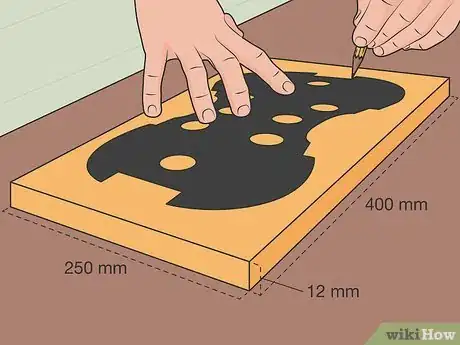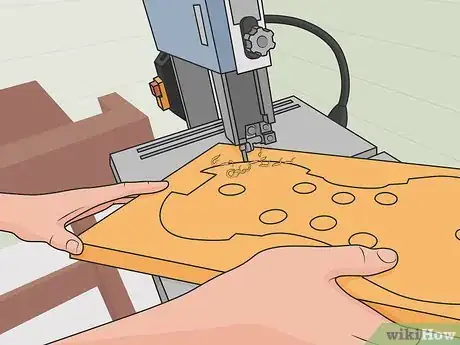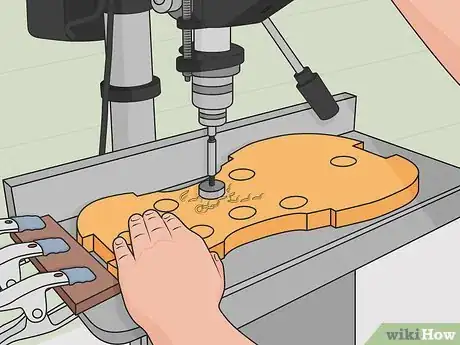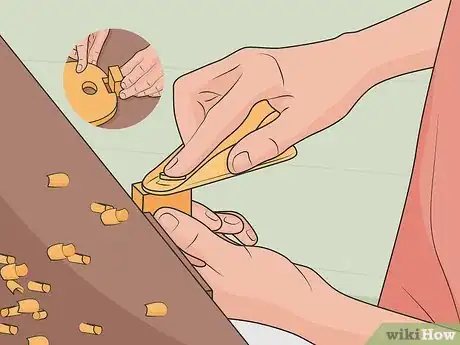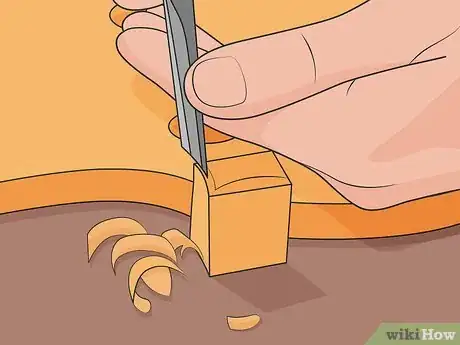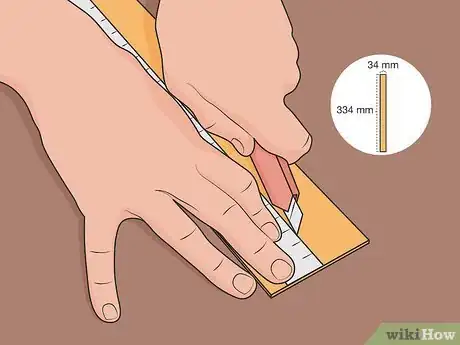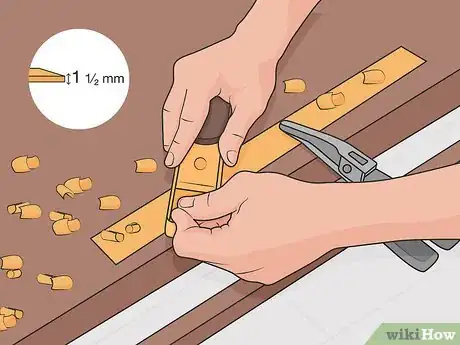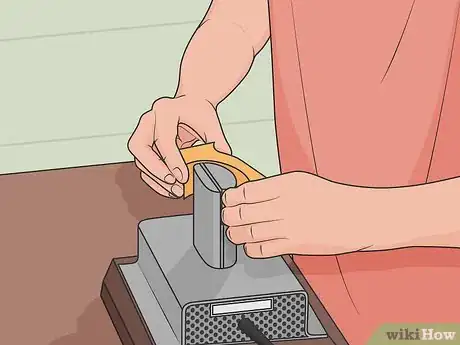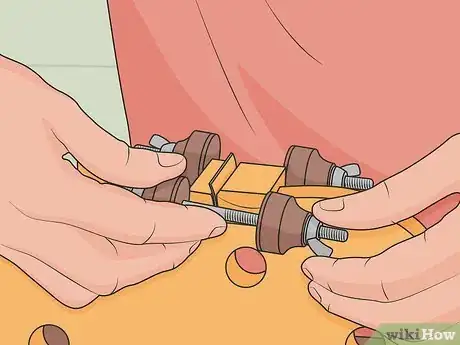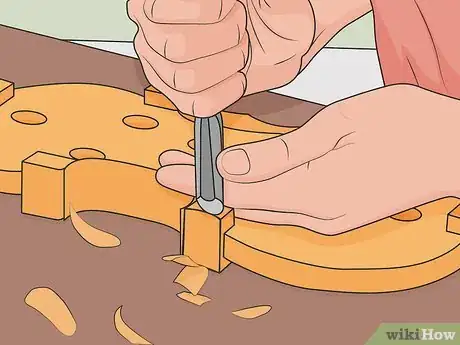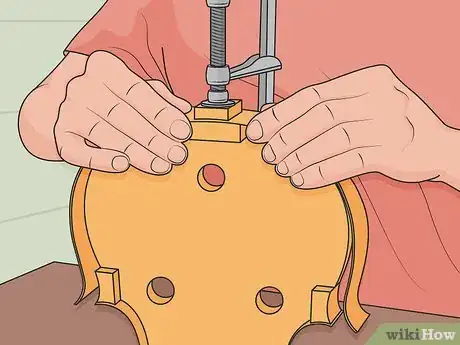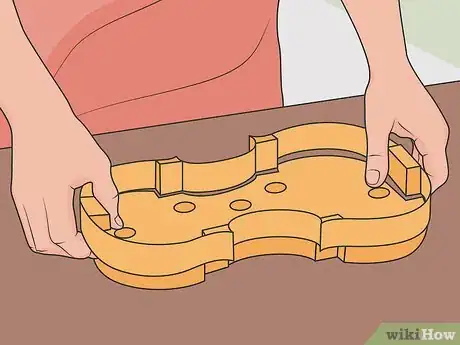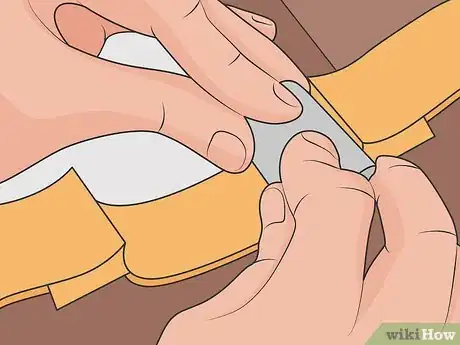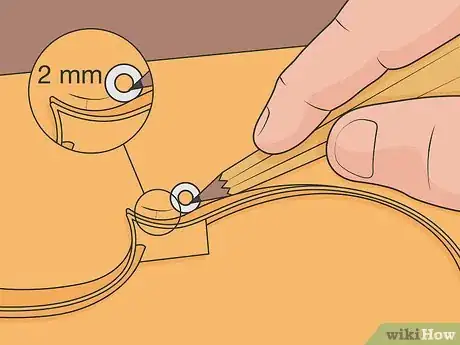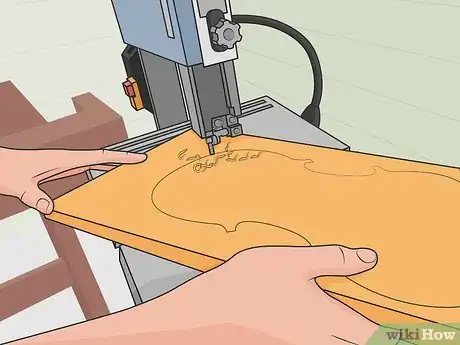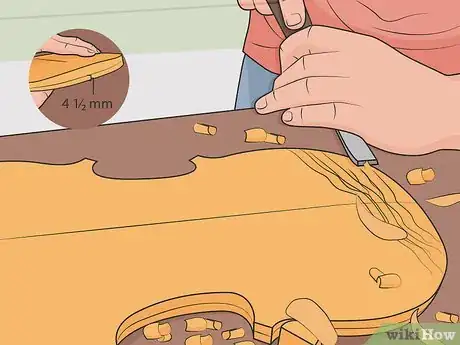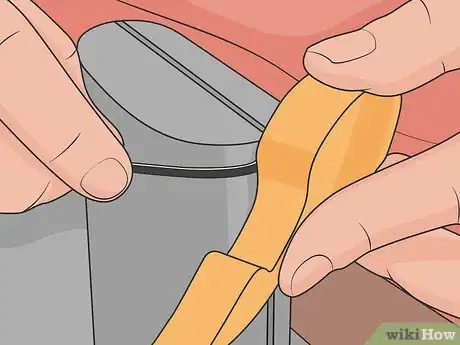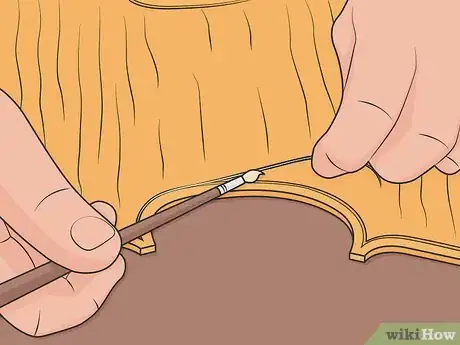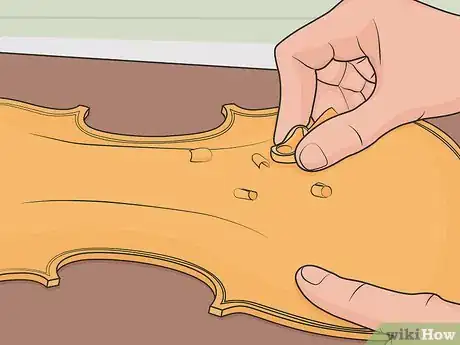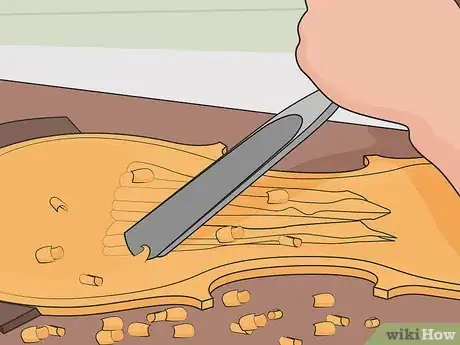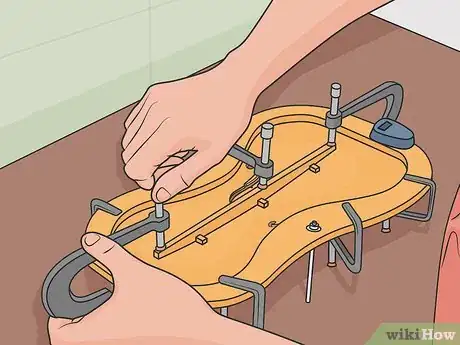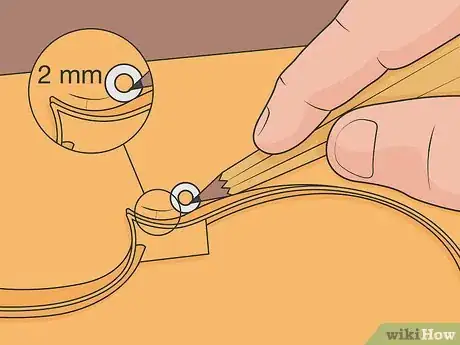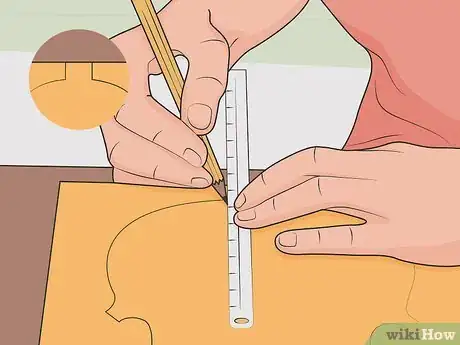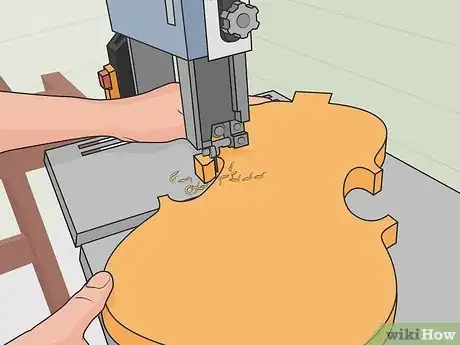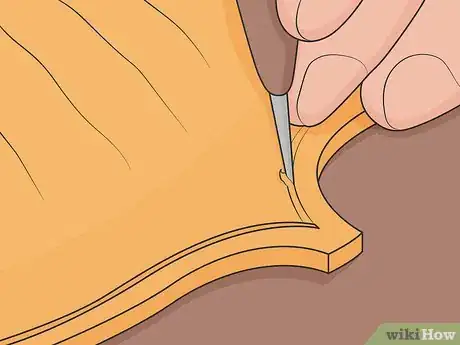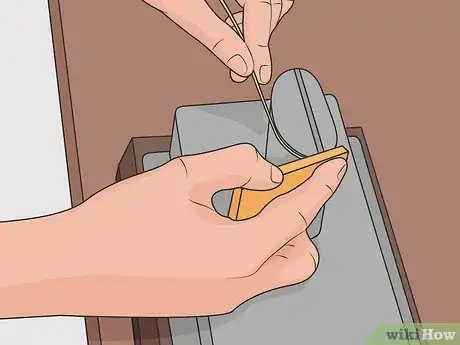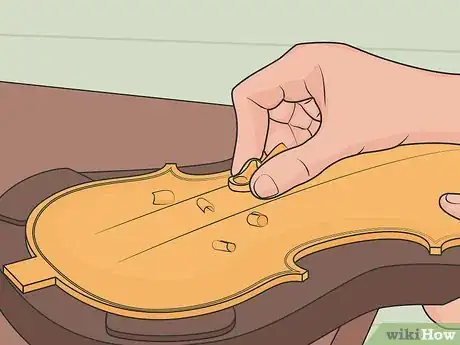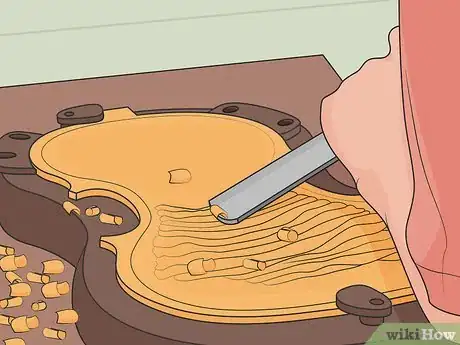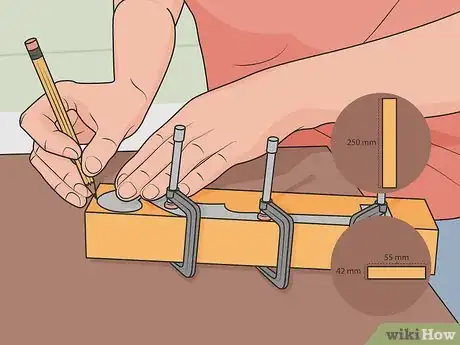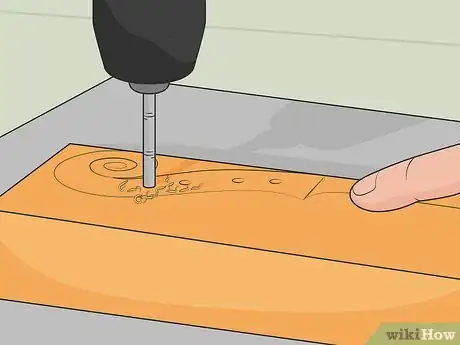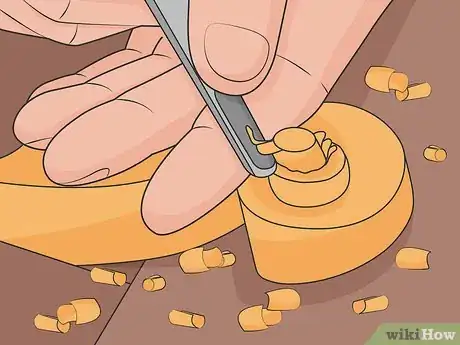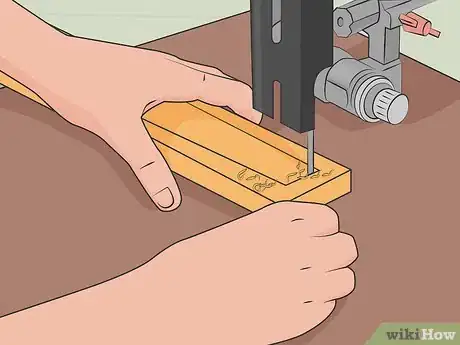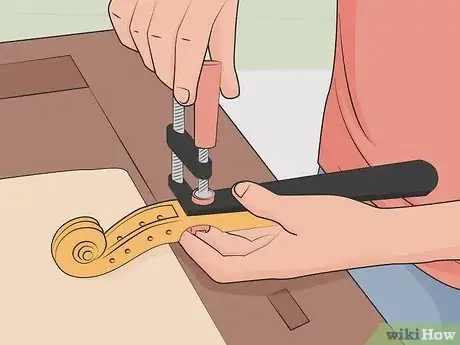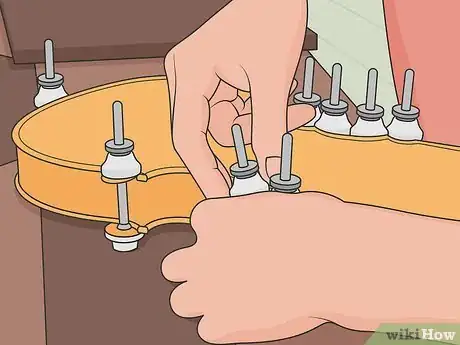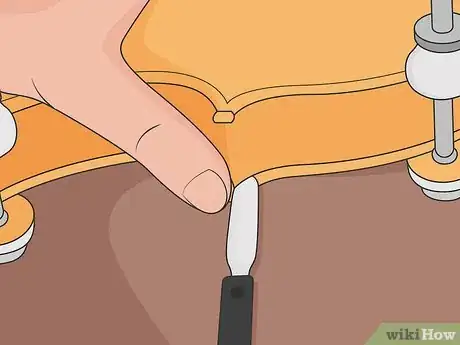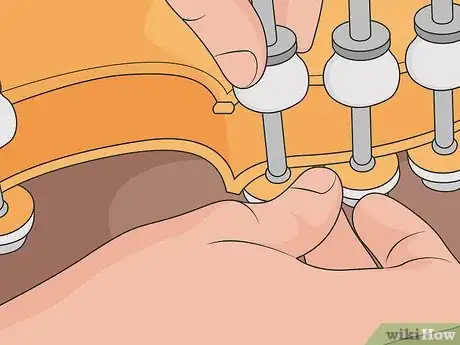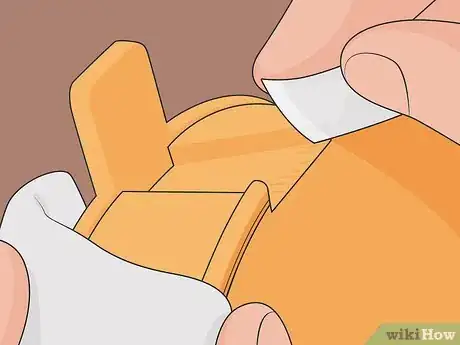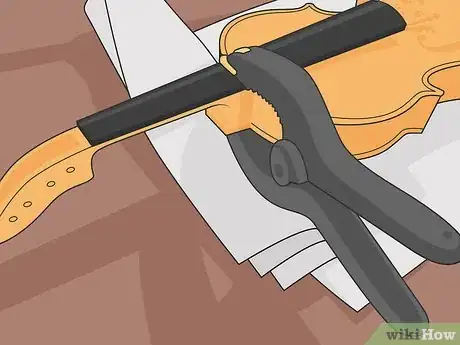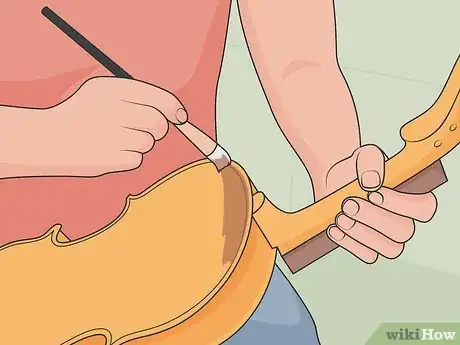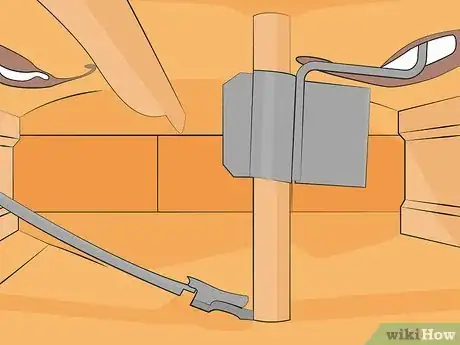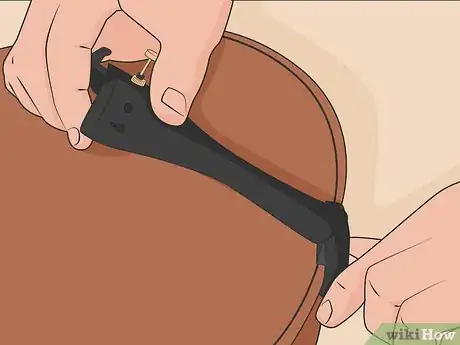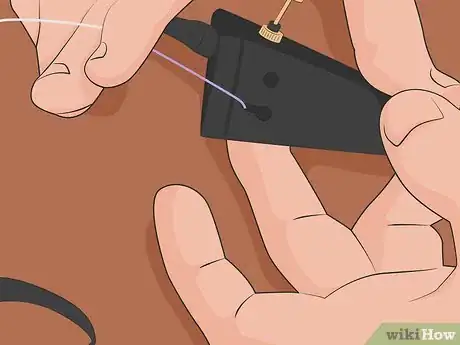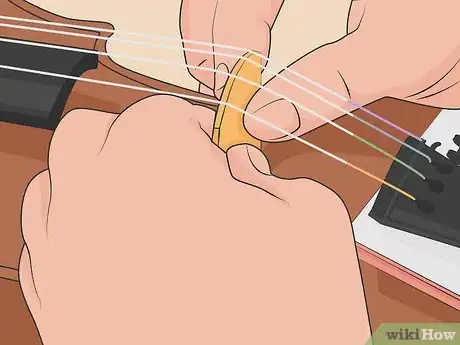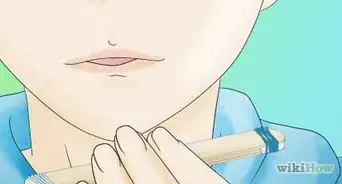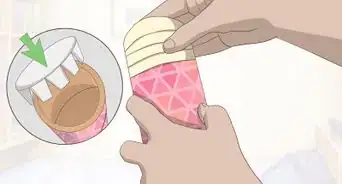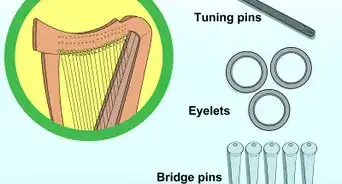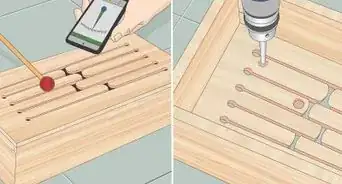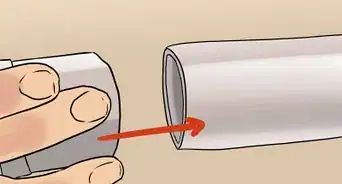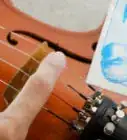This article was co-authored by Josh Goldenberg and by wikiHow staff writer, Hunter Rising. Josh Goldenberg is a Residential Remodeling Expert and the Co-Founder of 5blox, based in the Greater Los Angeles area. With more than seven years of experience, Josh and his team specialize in luxurious and sustainable home renovations. 5blox is fully licensed and bonded.
There are 28 references cited in this article, which can be found at the bottom of the page.
This article has been viewed 102,540 times.
Violins are the smallest stringed instrument in an orchestra and can be used for a wide variety of musical styles. While you can always buy a violin from a music store, making your own can create a unique sound and make your instrument one of a kind. Building a homemade violin can be a complicated and intricate process that requires a lot of time and patience, but it can be rewarding to play an instrument that you made yourself!
Steps
Building the Rib Structure
-
1Trace a violin mould template onto a piece of wood that’s 400 × 250 × 12 mm (15.75 × 9.84 × 0.47 in). Look online for templates for 4/4 violins, which are the standard sizes for adults, and print one out at full size so you can work off of it. Make sure the template you find has 8 large holes in the middle of the outline or else you won’t know where to cut. Transfer the outline directly onto a piece of plywood that’s 400 × 250 × 12 mm (15.75 × 9.84 × 0.47 in), making sure you’re as accurate as possible or else your finished violin may not fit together well.[1]
- Any type of plywood works for making your mould template since it won’t be included in the final instrument.
- You can choose a template for a smaller violin, such as a 1/2 or 3/4, if you want to make one for a younger violinist.
- Violin templates may vary slightly in size and decoration, so pick a template that you like to work from.
-
2Cut the rib mould out from your wood with a scroll saw. Put on safety glasses before you start working with your saw to protect your eyes. Turn on your scroll saw and carefully guide the blade around the outline for your template. Make sure the saw blade stays on the outside of your outline so you don’t remove too much material from the template. Work slowly around the edge of the entire outline until you're able to remove the piece from the block of wood.[2]
- If you aren’t able to remove all of the excess wood with your saw, use a sander or file to shape it to size.
- Be mindful of where the saw blade is at all times so you don’t accidentally cut yourself while you’re working.
- Try to avoid cutting sharp turns continuously when you're using a scroll saw. Instead, cut one angle and then cut another angle separately. You might find that backing out of your current cut and approaching from a different angle is helpful when cutting fine turns or small details.
Advertisement -
3Use a drill press to remove the holes from the middle of the template. Change the drill bit in the press to one that’s the same diameter as the circles on your template mould. Set the template on a drill press so the bit lines up with one of the circular holes you need to cut. Pull the handle down on the drill press to slowly cut through the hole. Let go of the handle to raise the drill bit and adjust your mould. Continue drilling all of the holes on the mould.[3]
- If you don’t have access to a drill press, then you can use a regular handheld drill with your largest drill bit to make a starting hole, and then use your scroll saw to cut along the holes’ outlines.
-
4Shape the wooden C-blocks to fit into the mould’s mortises. The mould has 6 different mortises on the top, bottom, and sides of the template that are used to hold the ribs, or sides, of the violin in place. Use blocks of wood and cut them to size using a bandsaw or scroll saw. Sand the edges of the blocks with 220-grit sandpaper so they can fit into the mortises on the mould perfectly.[4]
- The size of your top C-block is 32 by 50 by 22 millimetres (1.26 × 1.97 × 0.87 in).
- The bottom C-block will be 34 by 46 by 20 millimetres (1.34 × 1.81 × 0.79 in).
- The upper side C-blocks are 33 by 25 by 28 millimetres (1.30 × 0.98 × 1.10 in).
- The lower side C-blocks will be 33 by 25 by 28 millimetres (1.30 × 0.98 × 1.10 in).
Tip: Label the C-blocks and the mortises where they fit so you don’t forget where to place them later.
-
5Glue the C-blocks to the mortises of the mould. Spread a thin layer of wood glue on the longest side of each mortise on the template mould using your finger or a small flat paintbrush. Press the C-blocks into each of the mortises where they fit. Secure C-clamps onto the mould and blocks so one end of each clamp is in one of the holes you drilled. Leave the C-blocks clamped for at least 24 hours so the glue has time to set.[5]
- Only apply glue to one side of each mortise or else you won’t be able to easily remove it later.
-
6Chisel the C-blocks on the side to match the corners of your violin template. Lay the template you originally traced on top of the mould so you know where the corners on each side of the violin lie. Draw the corners onto the C-blocks glued to each side of the mould so you know what you need to cut off. Use a chisel to cut through the blocks so the C-shape on either side of the violin has a curved edge. Sand any rough edges with 220-grit sandpaper to smooth them down.[6]
- Don’t chisel the outer side of the C-block yet since it will help hold the ribs in place.
-
7Cut out the rib pieces of your violin so they’re 34 mm (1.3 in) wide. Look for a flexible sheet of maple wood that’s at least 334 millimetres (13.1 in) long to make your ribs. Run the sheet through a bandsaw or a circular saw to cut the pieces until they’re 34 millimetres (1.3 in) wide. Cut out 5-6 strips of wood to use for the ribs so you have enough to bend and shape around the outline of your template.[7]
- If you want to know exactly how long your strips need to be, measure around the edge of your mould with a flexible tape measure so you know the circumference of the instrument.
- Maple is the standard wood that violins are made from, but you can use other hardwoods if you want.
-
8Plane the ribs so they’re 1 1⁄2 mm (0.059 in) thick. Clamp the strips of wood to a flat work surface, and guide a wood plane on top of each strip to shave off some of their thickness. Continue planing each strip, checking the thickness after each pass until you reach 1 1⁄2 mm (0.059 in). Be careful not to take too much material off of the ribs since your instrument won’t be as sturdy otherwise.[8]
- Use a manual planer rather than an electric one since it will give you better control over the thickness.
-
9Soak the C-rib pieces in water for 2-3 minutes. The C-rib pieces are the shortest pieces that fit into the C-shaped sections on the sides of your violin. Submerge the strips under cold water so they can absorb some and become more flexible (and won’t burn when you start bending them). After 2-3 minutes, pull the strips out and shake off the excess water.[9]
- Only soak 2 of the strips you cut at first so the other pieces don’t get too waterlogged.
-
10Bend the C-ribs into shape using a bending iron. A bending iron is a round piece of heated metal used to heat wood and bend it into curves. Heat the bending iron to 200–250 °C (392–482 °F) before you start bending the ribs or else they may break. Guide the rib pieces over the bending iron and shape them around the curve on the iron. Try to get the curve close to matching with the C-shape curves on the sides of the violin mould.[10]
- You can buy a bending iron from your local hardware store or online.
- Wear gloves while working with a bending iron since it’s hot and will cause the wood to heat up as well.
- Be careful around the bending iron since it will cause severe burns if you touch it.
-
11Glue and clamp the C-ribs onto the mould. Guide the bent rib pieces into the C-shaped curves on the sides of the template mould and fit them tightly against the edge. Lift the ends of the ribs and place a small amount of glue on the C-blocks on the tops and bottoms of each curve. Press the rib pieces against the glue and place a flat piece of scrap wood between the C-blocks to hold the ribs in place. Clamp the scrap wood to the mould and let the glue dry for 24 hours.[11]
- If your rib pieces are too long for the curves, cut them down carefully with a utility knife so they extend 1–2 millimetres (0.039–0.079 in) past the points of the corner.
-
12Cut the C-blocks so they’re flush with the corners. Remove the clamps from your mould so you can easily cut off pieces from your C-blocks. Use a wood gouge or chisel to shape the C-blocks into the corners of the violin. Continue shaping the C-blocks until the edges are flush with the rest of your template mould and sand them if you need to smooth them out.[12]
- Be careful not to remove too much material from the C-blocks or else you may ruin the shape of your violin.
-
13Bend and glue the top and bottom ribs into place. Heat the bending iron to 200–250 °C (392–482 °F) while you soak the rib pieces for the top and bottom of your violin. Guide the rib pieces along the bending iron to shape them as closely as you can to the shape of the violin. Set the ribs along the edge of the template mould and press them tight against the side. Apply a small amount of glue to the ends and centers of the ribs so they adhere to the C-blocks. Clamp the ribs in place and let them dry for at least 24 hours so the glue has time to set.[13]
- You may need to use curved pieces of scrap wood to hold the ribs in position so they don’t dry crooked.
- You can either use 1 or 2 different rib pieces for both the top and bottom curves of the violin. It may be easier to shape 2 rib pieces than a single piece.
-
14Pop the ribs out from the mould once the glue has set. As soon as the glue is completely dry, undo the clamps and carefully try to pull the entire rib structure up and off of the mould. If it sticks in places, carefully shimmy a small chisel between the mould and the ribs so you can pry it out. Eventually, the ribs and the C-blocks will come free from the mould.[14]
- Don’t try to force the rib structure out of the mould since you could break the wood.
-
15Round the inside edges of the C-blocks with a file. Place the edge of a file on the inside edges of the C-blocks and carefully sand them down. Work the C-blocks on the side corners of the violin so they make a smooth curve that follows the angle of the rib pieces. Round the corners on the bottom and top pieces so they aren’t sharp.[15]
Carving the Front of the Violin
-
1Trace 2 mm (0.079 in) around the rib structure onto a piece of wood. Set your rib structure onto a piece of maple that’s at least 375 by 220 by 20 millimetres (14.76 × 8.66 × 0.79 in). Place a pencil along the edge of the rib structure and follow along the outline closely so your front piece is the right size. Hold your pencil at the same angle for the entire outline so it doesn’t affect your tracing.[16]
- Make sure the grain of the wood goes in the same direction as the violin or else it won’t be as sturdy.
- If you didn’t use maple for your rib pieces, then use the same wood for the front of your violin so it looks cohesive.
-
2Cut the shape for the front of your violin using a bandsaw. Wear safety glasses before starting on the bandsaw so you don’t hurt yourself. Guide the piece of wood through the blade of the saw to cut around the outside of the outline. Don’t cut right on your line or else the front piece will be too small when you try to attach it. Work your way around the sides of the piece until it’s completely cut out.[17]
- Use caution while working with a bandsaw so you don’t accidentally cut yourself.
Tip: If you have trouble cutting tight corners, you can use a scroll saw or file the area after it’s been cut.
-
3Gouge the outer border to a thickness of 4 1⁄2 mm (0.18 in). A wood gouge is a tool to remove and smooth out pieces of wood. Measure in from the edge of the front piece about 7 millimetres (0.28 in) so you know how much you need to gouge. Use a wood gouge to flatten the edge around the violin to make the platform, which is where the violin connects to the ribs. Continue flattening the edge of the front piece until it’s only 4 millimetres (0.16 in) thick.[18]
- You can buy a wood gouge from your local hardware store.
- Don’t remove too much material or else you could break through the bottom of the front piece.
-
4Carve a channel on the front piece that’s 3 1⁄2 mm (0.14 in) from the edges. Use a chisel or a wood gouge to carve the channel out of the violin. Measure in from the edge by 3 1⁄2 millimetres (0.14 in) and cut it to a depth of 2 millimetres (0.079 in). Work completely around the edge of the front piece so the channel goes completely around it.[19]
-
5Bend strips of purfling with your bending iron. Purfling is a decorative wooden border around the edge of your violin that also helps support the instrument. Heat up your bending iron to 200 °C (392 °F) and soak the strips in water for 2-3 minutes. Guide the purfling around the curves of the bending iron so they’re close to the curves in the channel you carved.[20]
- In total, you will need about 500 millimetres (20 in) of purfling for the front of your violin.
- Wear gloves while working with the bending iron so you don’t burn yourself.
- The bending iron is extremely hot and will cause severe burns if you touch it.
- You can buy purfling strips from a music shop or online.
-
6Glue purfling strips into the channel you just carved. Starting from the corners on the sides of the violin, apply a small amount of hot glue into the channel and guide the purfling into the shape. Press the purfling into the channel so it has firm contact with the glue and dries in place. If you need to, use a small hammer to tap the purfling into the channel.[21]
- You do not need to clamp the purfling in place since hot glue sets quickly.
- Don’t apply hot glue directly on the purfling since the glue could cause it to warp.
-
7Use a wood scraper to arch the violin along the center line. Guide a wood scraper down the length of the violin to remove the excess wood that’s on top. Make smooth slopes coming from the center of the violin to the flat edge around the outside you already carved. Make sure the highest point of the arch is about 16–18 millimetres (0.63–0.71 in) up from the bottom of the piece.[22]
- As you start working on more detailed sections of the violin, switch to smaller hand planes so you can be more accurate with how much wood you remove.
-
8Flip the front of the violin over to carve out the backside. Flip the wood over so the arched side is face-down. Clamp the front piece in place so you can easily hollow out the bottom of the violin. Leave the area that’s 7 millimetres (0.28 in) from the edge flat and use a wood scraper or gouge to hollow out the center of the violin. Continue removing material until it’s between 4–6 millimetres (0.16–0.24 in) thick.[23]
- Be gentle while working with your violin since you could break the wood if you use too much force.
- Make sure you use new, sharp tools to make cutting the wood easier.
-
9Cut out the f-holes for your violin. The f-holes are the hollowed-out sections where the sound of the violin comes from. Flip the front piece over so the arched side is face-up again, and position the f-holes so the top of each one is 42 millimetres (1.7 in) from one another and about 150 millimetres (5.9 in) from the top of the piece. Use a handheld drill to bore through the spots where you’re placing the f-holes and then use a scroll saw to cut out the shape.[24]
- You can print out templates for f-holes so they’re already positioned correctly and so you don’t need to draw them freehand.
-
10Glue a bass bar onto the backside of the front piece. Turn the front piece over so the hollowed-out side is face-up. Cut a piece of spruce to 350 by 20 by 8 millimetres (13.78 × 0.79 × 0.31 in) and plane the sides so they’re parallel with one another. Place the bass bar so it’s 12 millimetres (0.47 in) to the right of the center line of the instrument. Glue the bass bar in place with wood glue and clamp it in place for 24 hours. When the glue is set, you can remove the clamp.[25]
- The bass bar helps the sound inside your violin resonate to make a more pleasant tone.
- Spruce is the traditional wood to use for a violin, but you can use other hardwoods if you want.
Shaping the Violin Back
-
1Trace 2 mm (0.079 in) around the rib structure onto a flat piece of wood. Place your rib structure on a piece of wood that’s 375 by 220 by 20 millimetres (14.76 × 8.66 × 0.79 in), and make sure the wood grain follows the length of the mould. Put the point of your pencil against the edge of the rib structure and slowly trace around the outline so you know what shape to cut out from your wood.[26]
- Don’t change the angle that you’re holding your pencil since it could affect the size and shape of your outline.
-
2Draw a platform in the top center of your outline for the neck button. The neck piece of your violin directly connects to the bottom of the instrument, so you need to include a platform at the top, also known as the button. Use a straightedge to draw a 22 mm (0.87 in) line that intersects the center line of the violin. Extend straight lines down from the ends of the one you just drew so they connect with the outline you traced.[27]
- Make sure the button is symmetrical across the centerline or else the violin neck will be crooked when you place it.
-
3Cut the bottom piece out using a bandsaw. Wear safety glasses while you work so you don’t get anything in your eyes. Guide the piece of wood through the bandsaw, slowly working around the curves of the instrument. Make sure you cut outside of the outline you drew so you don’t remove too much material from the back piece.[28]
- If you can’t cut out the details around the corners with a bandsaw, then use a file or a scroll saw instead.
-
4Carve a channel around the outside border of the back piece. Measure 3 1⁄2 millimetres (0.14 in) in from the edge of the back piece and use a gouge to cut a channel into the back. Make sure the channel is about 2 millimetres (0.079 in) thick and deep so you can easily fit the purfling strips into them later.[29]
- Work slowly so you don’t accidentally remove too material, or else the purfling won’t have a tight fit.
-
5Bend and glue purfling into the channel you just carved. Heat your bending iron to 200 °C (392 °F) and soak the purfling strips in water for 2-3 minutes so they don’t burn. Guide the purfling strips around the curves of the bending iron so they closely resemble the channel you carved out. Starting in the corners of the instrument, apply hot glue in the channel and tap the purfling into place. Let the glue set completely before continuing.[30]
- You will need about 500 millimetres (20 in) of purfling for the back of your violin.
- Use the same purfling you used on the front piece so your instrument looks cohesive.
Tip: If you can’t get the purfling into the channel, tap it lightly with a hammer until it lies flush.
-
6Carve the back piece of your violin so it arches in the center. Use a wood plane or scraper to curve the wood on the back piece. Keep the center of the instrument 16 millimetres (0.63 in) tall and smoothly arch the wood toward the edges, which you can plane down to 6 millimetres (0.24 in) thick. As you start working on smaller detailed areas of the violin, switch to smaller hand planes or a thumb plane to control how much wood you’re removing.[31]
- Try to get the back of the violin as smooth as possible with your hand plane so it has a gentle curve.
-
7Flip the back piece over and hollow out the wood. Set the back piece on your work surface so the arched side is face-down. Clamp the back piece in place and use a wood scraper to hollow out the bottom. Keep the edges flat so you can easily attach them to the ribs later, but remove enough wood in the middle so that the back piece is only 4–6 millimetres (0.16–0.24 in) thick.[32]
- Don’t use too much pressure or remove too much material since you could break the wood or affect the sound of the final instrument.
Carving the Neck
-
1Trace a template for the violin’s neck onto a block of wood. Use a template for the neck that matches the body of the violin you’re making. Print out the templates for the profile and top-down view of the neck, and transfer the outlines to a block of wood that’s at least 250 by 42 by 55 millimetres (9.8 × 1.7 × 2.2 in). Make sure the grain of the wood goes in the same direction as the length of the neck or else it won’t be as strong.[33]
-
2Drill through the peg hole locations on your template. Look where the 4 holes on the side of the violin’s neck line up and find a drill bit that’s the same size. Set the wood block underneath a drill press and make sure the hole lines up with the drill bit. Pull the handle on the drill press to cut through the wood. Once you drill through the wood, ease the handle back up to pull the drill bit out. Repeat the process for the other 3 holes along the neck.[34]
- Wear safety glasses while working with a drill press so you don’t get any sawdust in your eyes.
- If you don’t have a drill press, use a handheld drill with a matching drill bit.
-
3Cut out your template from the block of wood. Use a bandsaw to cut out the main shape of the neck. Keep your cuts outside of the lines you drew so you don’t cut the neck too small. Start by working from the profile view so you can cut out the general shape of the neck first. Then work from the outline for the top-down view so the neck is the correct thickness.[35]
- You may need to redraw either your top-down or profile outline as you cut off more wood.
-
4Carve out the scroll and peg box with a chisel. Work with a gouge and chisel to detail your neck and remove any wood you couldn’t get off with your saw. Carve out a rectangular shape between the holes you drilled to make the peg box, which is where you’ll place your tuning pegs and strings. Then add details to the scroll, which is spiraled part at the end of the neck. Follow your template closely to remove the excess wood.[36]
- The peg box is usually 72 millimetres (2.8 in) long and 19 1⁄2 millimetres (0.77 in) wide.
Tip: The scroll doesn’t have to look perfect since it doesn’t affect the sound of the instrument. You can work as much or as little on the scroll as you want.
-
5Cut the fingerboard out from a piece of ebony. Use a block of ebony that’s about 280 by 50 by 15 millimetres (11.02 × 1.97 × 0.59 in) to use for your fingerboard. Draw the outline from a template onto your piece of ebony so the bottom edge of the fingerboard is wider than the top edge. Use a bandsaw to cut through the ebony along your outlines and arch the fingerboard so it’s 10 millimetres (0.39 in) thick at the tallest point. Hollow out the bottom at the wide end of the fingerboard so it’s arched and the wood is 6 millimetres (0.24 in) thick.[37]
- Ebony is the traditional material used for the neckboard, but you can use any type of hardwood if you need to.
-
6Glue the fingerboard to the neck. Spread your wood glue on the bottom side of the fingerboard with your finger or a small paintbrush so it has an even application. Press the fingerboard in the center of the neck and clamp it in 3 different places along the length so it adheres to the neck. Let the glue set for 24 hours before removing the clamps and continuing your work.[38]
- Put cushions or something soft between the wood and your clamps if you don’t want to leave any marks or scratches on the fingerboard or neck.
Assembling the Body
-
1Clamp the back piece to the rib structure with multiple spool clamps. Set the rib structure on a flat work surface and place the back piece on top of it. Carefully line up the edges of the back piece with the edges of the rib structure and clamp them in place. Use about 32 spool clamps total so you can apply even pressure around the sides of the back piece and rib structure.[39]
- You can find a diagram of where to place your spool clamps here: http://www.makingtheviolin.com/Fitting%20the%20back.
-
2Apply your glue between the back piece and the ribs with a knife. Take off 2-3 clamps near one of the corners of your violin so you can apply the glue. Dip the blade of a parting knife into the glue you’re using and slide the blade between the rib structure and the back piece. The glue will transfer to the edge of the ribs and adhere to the back piece. Reclamp the area, making sure everything is still aligned.[40]
- Pull the rib structure and back piece slightly apart with your hands if you can’t fit the knife easily between them.
Tip: Be sure to wipe the blade of your knife after you apply the glue so it doesn’t become difficult to use.
-
3Work your way around the back piece and let the glue dry. Continue gluing the rest of the corners by removing clamps, applying the glue with your knife, and then again clamping them. Once the corners are glued, work around the curves of the instrument so the glue holds the pieces together. Once you’ve applied glue around the entire back piece, let the glue set for at least 24 hours before removing your clamps.[41]
- Before you put the clamps back on, make sure the back piece is still lined up with the edges of the rib structure so you don’t accidentally warp the wood.
-
4Repeat the process for attaching the front side. After the back piece is attached, line up the front piece on the opposite side of the rib structure and clamp it in place so it doesn’t move around. Apply glue to the corners first, and slowly work around the curves until it’s completely glued. Tighten your clamps and let the glue set for at least 24 hours so it can completely dry.[42]
-
5Cut out a mortise in the top piece and ribs for the neck piece. The bottom of the neck piece connects to the button you made on the bottom piece, but it also cuts into the top piece of the instrument slightly. Dry-fit the neck into place and mark the thickness on the front piece and rib structure. Use a utility knife or a sharp chisel to cut out the rib material and edge of the front piece.[43]
- Work slowly while you’re cutting out the mortise since you could damage the rest of the violin.
-
6Glue the neck piece to the violin body. Apply a layer of glue to the mortise, the button on the back piece, and the neck joint. Press the neck piece into place and make sure the center lines up with the middle of the instrument. Clamp the neck in place and let it dry for at least 24 hours so the glue has time to set.[44]
- Wipe off any excess glue so it doesn’t dry on the violin’s body and cause any damage.
-
7Apply 2-3 coats of varnish onto the violin body. Use an oil-based varnish for your violin to change the color of the wood and make it shiny. Use a small flat paintbrush to paint a thin coat of the varnish onto the maple pieces of your violin. Wait for the first coat of varnish to dry for at least 24 hours before applying a second coat. You can add as many coats of the varnish as you want to change the instrument’s color.[45]
- Don’t apply varnish to the fingerboard since it could affect the overall sound of the instrument.
Adding the Peripherals
-
1Place the tuning pegs in the holes you drilled on the neck. The tuning pegs tighten the strings and are what you use to tune the instrument. Place the pegs for the A-string and E-string in the first hole, which is the top one, and the third hole from the right side of the instrument. Put the pegs for the D-string and G-string in the second and fourth holes from the left side and tap them into place so they go completely through the peg box.[46]
- You can buy tuning pegs online or from music supply stores.
- Make sure the pegs for the correct strings are in the right place, or else your strings won’t sit correctly on the instrument.
-
2Put the soundpost inside of the violin. The soundpost is a small dowel placed inside the violin that helps the instrument resonate. Put the soundpost in the jaws of a soundpost setter and guide it through the f-hole on the front of your violin. Move the soundpost into the center of the violin and make sure it fits tightly between the top and bottom pieces of the violin. Let go of the soundpost and pull the setting tool back out.[47]
- You can buy soundposts and soundpost setting tools from music stores or online.
Tip: Angle a mirror so you can see through the other f-hole so you can determine if the soundpost is set in place.
-
3Attach the tailpiece to the bottom of the violin. Drill a 6 mm (0.24 in) hole in the center of the ribs on the end of your violin. Screw an end pin into the hole so you can hook the tailpiece around it. Set the tailpiece against the bottom edge of the violin so it lines up with your fingerboard and hook the looping metal piece around the end pin to secure it.[48]
- You can buy a tailpiece from a music store or online.
-
4Put the strings on so they stretch between the tailpiece and tuning pegs. Place your strings in the proper tuning pegs and start winding them to add a small amount of tension to them. Place the other ends of the strings in the base of the tailpiece so you can secure them in place. Tighten the strings until they feel taut across the instrument.[49]
- From left to right, the strings should be G, D, A, and E.
- You can buy new violin strings from music stores or online.
-
5Set the bridge for the violin underneath the strings near the end of the fingerboard. The bridge supports the strings, lifts them away from the body of the violin, and helps them resonate throughout the instrument. Slide the bridge into position about 50 millimetres (2.0 in) from the end of the fingerboard and stand it up so the arched side touches the strings. Position the feet of the bridge at a 90-degree angle to the body of the violin.[50]
- You can buy violin bridges from music stores or online.
- The tension of the strings will hold the bridge in place so you do not need to use any glue or adhesive.
Community Q&A
-
QuestionDo I use a hot glue gun or a glue stick?
 Community AnswerHide glue is the only glue that should be used on a violin. This must be applied hot. Hide glue has the correct properties for holding a violin together, but almost more importantly it can be taken apart to do instrument repairs at a later date.
Community AnswerHide glue is the only glue that should be used on a violin. This must be applied hot. Hide glue has the correct properties for holding a violin together, but almost more importantly it can be taken apart to do instrument repairs at a later date. -
QuestionOther than spruce and maple, are there any other woods to use, like maybe oak?
 Community AnswerOn Violas and Cellos the backs are sometimes made of poplar or willow, but for violins it's almost always maple. Oak would be far too heavy and rough grained for making an instrument. Its important also that the wood should be air dried for at least 5 years after the tree is cut. For the fingerboard, upper nut, and saddle a very dense, even grained tropical wood should be used. (usually ebony, though rosewood can work as a cheaper option).
Community AnswerOn Violas and Cellos the backs are sometimes made of poplar or willow, but for violins it's almost always maple. Oak would be far too heavy and rough grained for making an instrument. Its important also that the wood should be air dried for at least 5 years after the tree is cut. For the fingerboard, upper nut, and saddle a very dense, even grained tropical wood should be used. (usually ebony, though rosewood can work as a cheaper option). -
QuestionWhich strings do I use?
 Community AnswerIt depends on the quality of the violin you are constructing. There generally are three main string types people use. Beginners usually use basic steel strings. Intermediate players may invest in an instrument with Dominant strings. Advanced and professional players tend to stick with Vision strings.
Community AnswerIt depends on the quality of the violin you are constructing. There generally are three main string types people use. Beginners usually use basic steel strings. Intermediate players may invest in an instrument with Dominant strings. Advanced and professional players tend to stick with Vision strings.
Warnings
- Wear safety glasses while you work with power tools to protect your eyes.⧼thumbs_response⧽
- Use caution while working with saws and power tools so you don’t accidentally hurt yourself.⧼thumbs_response⧽
- Bending irons get extremely hot, so be sure not to touch them or else you will severely burn yourself.⧼thumbs_response⧽
Things You’ll Need
- 400 × 250 × 12 mm (15.75 × 9.84 × 0.47 in) piece of plywood
- 400 × 200 × 120 mm (15.7 × 7.9 × 4.7 in) piece of spruce
- 355 by 140 millimetres (14.0 in × 5.5 in) sheet of flexible maple
- 2 pieces of maple wood that are 375 by 220 by 20 millimetres (14.76 × 8.66 × 0.79 in)
- 250 by 42 by 55 millimetres (9.8 × 1.7 × 2.2 in) block of maple
- 280 by 50 by 15 millimetres (11.02 × 1.97 × 0.59 in) piece of ebony
- Pencil
- Safety glasses
- Scroll saw
- Drill press
- Wood glue
- Paintbrush
- Wood plane
- Bending iron
- Work gloves
- C-clamps
- Chisel
- Washer
- Bandsaw
- File
- Wood gouge
- Purfling strips
- Hot glue gun and hot glue
- Wood scraper
- Spool clamps
- Parting knife
- Tuning pegs
- Soundpost
- Soundpost setter
- End pin
- Tailpiece
- Violin strings
- Bridge
References
- ↑ http://www.makingtheviolin.com/Mould
- ↑ http://www.makingtheviolin.com/Mould
- ↑ http://www.makingtheviolin.com/Mould
- ↑ http://www.makingtheviolin.com/Mould
- ↑ http://www.makingtheviolin.com/Mould
- ↑ http://www.makingtheviolin.com/Cutting%20the%20C%20blocks
- ↑ http://www.makingtheviolin.com/Preparing%20the%20ribs
- ↑ http://www.makingtheviolin.com/Preparing%20the%20ribs
- ↑ http://www.makingtheviolin.com/Bending%20the%20C%20ribs
- ↑ http://www.makingtheviolin.com/Bending%20the%20C%20ribs
- ↑ http://www.makingtheviolin.com/Bending%20the%20C%20ribs
- ↑ http://www.makingtheviolin.com/Gluing%20the%20top%20and%20bottom%20ribs
- ↑ http://www.makingtheviolin.com/Gluing%20the%20top%20and%20bottom%20ribs
- ↑ http://www.makingtheviolin.com/Finishing%20the%20rib%20structure
- ↑ http://www.makingtheviolin.com/Finishing%20the%20rib%20structure
- ↑ https://www.classicfm.com/discover-music/instruments/violin/how-to-make-a-violin/
- ↑ https://www.classicfm.com/discover-music/instruments/violin/how-to-make-a-violin/
- ↑ http://www.makingtheviolin.com/Creating%20the%20platform
- ↑ http://www.makingtheviolin.com/Marking%20and%20cutting%20the%20purfling%20channel
- ↑ http://www.makingtheviolin.com/uploads/makingtheviolinmanual.pdf
- ↑ http://www.makingtheviolin.com/uploads/makingtheviolinmanual.pdf
- ↑ http://www.makingtheviolin.com/Arching
- ↑ http://www.makingtheviolin.com/Hollowing%20and%20thicknessing
- ↑ http://www.makingtheviolin.com/Cutting%20the%20f-holes
- ↑ http://www.makingtheviolin.com/uploads/makingtheviolinmanual.pdf
- ↑ http://www.makingtheviolin.com/Back
- ↑ http://www.makingtheviolin.com/Back
- ↑ https://www.classicfm.com/discover-music/instruments/violin/how-to-make-a-violin/
- ↑ http://www.makingtheviolin.com/Back
- ↑ http://www.makingtheviolin.com/Back
- ↑ http://www.makingtheviolin.com/Back
- ↑ http://www.makingtheviolin.com/Back
- ↑ http://www.makingtheviolin.com/Preparing%20the%20neck%20block
- ↑ http://www.makingtheviolin.com/Preparing%20the%20neck%20block
- ↑ http://www.makingtheviolin.com/Preparing_the_neck_block
- ↑ http://www.makingtheviolin.com/Cutting%20the%20volute
- ↑ http://www.makingtheviolin.com/Preparing%20the%20fingerboard%20block
- ↑ http://www.makingtheviolin.com/Gluing%20the%20fingerboard
- ↑ http://www.makingtheviolin.com/Fitting%20the%20back
- ↑ http://www.makingtheviolin.com/Fitting%20the%20back
- ↑ http://www.makingtheviolin.com/Fitting%20the%20back
- ↑ http://www.makingtheviolin.com/Fitting_the_front
- ↑ http://www.makingtheviolin.com/Fitting_the_neck
- ↑ http://www.makingtheviolin.com/Fitting_the_neck
- ↑ http://www.makingtheviolin.com/Varnish
- ↑ http://www.makingtheviolin.com/Pegs%20and%20endpin
- ↑ http://www.makingtheviolin.com/Soundpost
- ↑ http://www.makingtheviolin.com/Tailpiece
- ↑ http://www.makingtheviolin.com/Strings
- ↑ http://www.makingtheviolin.com/Bridge
